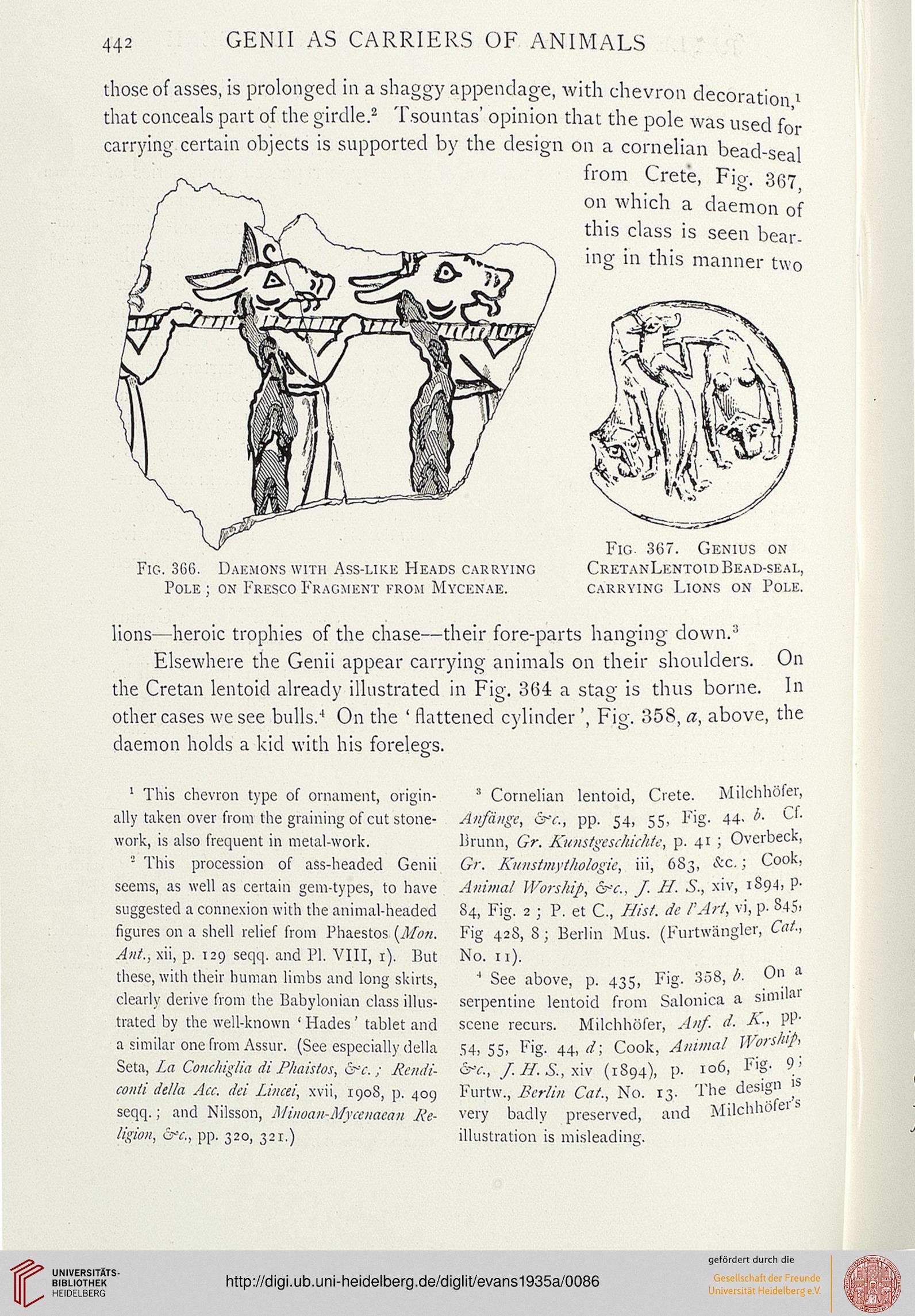442
GENII AS CARRIERS OF ANIMALS
those of asses, is prolonged in a shaggy appendage, with chevron decoration >
that conceals part of the girdle.2 Tsountas' opinion that the pole was used for
..... ' ■ " ' " " ' "" on a cornelian '
from Crete, Fio-. 3(57
on which a daemon of
this class is seen bear-
ing in this manner two
; gnuie.- 1 suuiuas opinion mar. rne pole was used for
carrying certain objects is supported by the design on a cornelian bead-seal
Fig. 366. Daemons with Ass-like Heads carrying
Pole ; on Fresco Fragment from Mycenae.
Fig. 367. Genius on
Cretan Lentoid Bead-seal,
carrying Lions on Pole.
lions—heroic trophies of the chase—their fore-parts hanging down.3
Elsewhere the Genii appear carrying animals on their shoulders,
the Cretan lentoid already illustrated in Fig. 364 a stag is thus borne.
On
In
other cases we see bulls/' On the ' flattened cylinder
daemon holds a kid with his forelegs.
, Fio-. 358, a, above, the
1 This chevron type of ornament, origin-
ally taken over from the graining of cut stone-
work, is also frequent in metal-work.
■ This procession of ass-headed Genii
seems, as well as certain gem-types, to have
suggested a connexion with the animal-headed
figures on a shell relief from Phaestos {Man.
Ant., xii, p. 129 seqq. and PI. VIII, 1). But
these, with their human limbs and long skirts,
clearly derive from the Babylonian class illus-
trated by the well-known 'Hades' tablet and
a similar one from Asstir. (See especially della
Seta, La Conchiglia di Phaistos, 6-v. ; Rendi-
conii della Ace. del Lincei, xvii, 190S, p. 409
seqq.; and Nilsson, Minoan-Mycenaean Re-
ligion, &c,, pp. 320, 321.)
s Cornelian lentoid, Crete. MUchhSfer,
Anfange, 6Vv., pp. 54, 55, Fig- 44- ''■ L
Brunn, Gr. Kunstgeschichte, p. 4' ; Oveibeck,
Or. Kunstmythologie,
&c. : Cook,
Gr. Kunstmythologie, iii, 683, ftc; cook,
Animal Worship, &~c, J. H. S., xiv, 1S94, P-
S4, Fig. 2 ; P. et C, Hist, de /'An, vi, p. S45.
Fig 42S, 8; Berlin Mus. (Furtwangler, Cat.,
No. n).
■' See above, p. 435, Fig. 358, I). On a
serpentine lentoid from Salonica a sinulai
scene recurs. Milchhofer, Anf. a. A., It-1
54, 55, Fig. 44, d; Cook, Animal Worship,
&-c, f.X.&, xiv (1S94), P- lo6> Flg- V
Furtw, Berlin Cat., No. 13- The design is
very badly preserved, and Mflchhofei s
illustration is misleading.
GENII AS CARRIERS OF ANIMALS
those of asses, is prolonged in a shaggy appendage, with chevron decoration >
that conceals part of the girdle.2 Tsountas' opinion that the pole was used for
..... ' ■ " ' " " ' "" on a cornelian '
from Crete, Fio-. 3(57
on which a daemon of
this class is seen bear-
ing in this manner two
; gnuie.- 1 suuiuas opinion mar. rne pole was used for
carrying certain objects is supported by the design on a cornelian bead-seal
Fig. 366. Daemons with Ass-like Heads carrying
Pole ; on Fresco Fragment from Mycenae.
Fig. 367. Genius on
Cretan Lentoid Bead-seal,
carrying Lions on Pole.
lions—heroic trophies of the chase—their fore-parts hanging down.3
Elsewhere the Genii appear carrying animals on their shoulders,
the Cretan lentoid already illustrated in Fig. 364 a stag is thus borne.
On
In
other cases we see bulls/' On the ' flattened cylinder
daemon holds a kid with his forelegs.
, Fio-. 358, a, above, the
1 This chevron type of ornament, origin-
ally taken over from the graining of cut stone-
work, is also frequent in metal-work.
■ This procession of ass-headed Genii
seems, as well as certain gem-types, to have
suggested a connexion with the animal-headed
figures on a shell relief from Phaestos {Man.
Ant., xii, p. 129 seqq. and PI. VIII, 1). But
these, with their human limbs and long skirts,
clearly derive from the Babylonian class illus-
trated by the well-known 'Hades' tablet and
a similar one from Asstir. (See especially della
Seta, La Conchiglia di Phaistos, 6-v. ; Rendi-
conii della Ace. del Lincei, xvii, 190S, p. 409
seqq.; and Nilsson, Minoan-Mycenaean Re-
ligion, &c,, pp. 320, 321.)
s Cornelian lentoid, Crete. MUchhSfer,
Anfange, 6Vv., pp. 54, 55, Fig- 44- ''■ L
Brunn, Gr. Kunstgeschichte, p. 4' ; Oveibeck,
Or. Kunstmythologie,
&c. : Cook,
Gr. Kunstmythologie, iii, 683, ftc; cook,
Animal Worship, &~c, J. H. S., xiv, 1S94, P-
S4, Fig. 2 ; P. et C, Hist, de /'An, vi, p. S45.
Fig 42S, 8; Berlin Mus. (Furtwangler, Cat.,
No. n).
■' See above, p. 435, Fig. 358, I). On a
serpentine lentoid from Salonica a sinulai
scene recurs. Milchhofer, Anf. a. A., It-1
54, 55, Fig. 44, d; Cook, Animal Worship,
&-c, f.X.&, xiv (1S94), P- lo6> Flg- V
Furtw, Berlin Cat., No. 13- The design is
very badly preserved, and Mflchhofei s
illustration is misleading.





